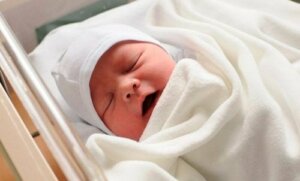The Strange Noises Babies Make When Breathing

When they’re still newborns, most of the strange noises babies make when breathing are due to the fact that their nostrils are quite small, which it’s somewhat more difficult for the air to move in and out. In many cases, these more or less normal noises are increased when there’s mucus in their nose.
Although the noises are strange, in most cases, they’re easy to resolve. If it’s mucus, just keep their nose free of it; Suction or clean them with seawater-based nasal sprays. Another solution is to not lay your baby down completely, but rather slightly inclined.
However, many mothers, and especially new moms, worry a lot about everything that may seem strange in their children. Well, to a certain extent, they’re right because in some cases, these strange noises that babies make could be a sign of a breathing problem that deserves to be treated urgently.
The reasons for the strange noises babies make when breathing
This condition is called laryngomalacia or tracheomalacia and it has to do with the weak quality of the walls that make up their trachea or perhaps their larynx. This weakness is due particularly to the lack of maturity of these organs. It’s not really risky and usually disappears well before the child’s first birthday.
As we’ve said, in most cases, there’s a normal explanation for the strange sounds babies make when breathing. However, the concern is recurrent in parents. And the truth is, there is a chance that it’s a sign of a serious problem; for example, when it’s difficult for your child to breathe.
In any case, it’s important to determine if it’s immaturity, according to where the noise comes from, if it’s from the nose or throat. Once the origin of the problem has been identified, a specialist will be able to explain to you how to act in these circumstances.

Your baby makes strange noises while sleeping and eating
The fact that a baby makes these strange noises that worry us so much in different situations can also have an explanation. For example, if they do it while they’re asleep, it may be related to the excess mucus present. This is something that we know how to solve by aspirating the mucus; it’s also possible that the sound is produced by a vibration that occurs due to the sleeping position.
In the event that the sounds occur during breastfeeding, it’s because the child is drinking your milk in a hurry, which prevents them from breathing regularly. This noise is normal because it occurs the moment they resume breathing after swallowing your milk; To avoid this, it’s best to feed babies on time so that they’re not so eager to eat.
If you notice that your baby suddenly makes strange noises a few minutes after eating, it may be because there are still traces of milk in their airway. In these cases, your should wait for it to pass. But if it takes time to do so, you can try giving your baby a little water to relieve it.
Even though it’s normal, you should still pay attention
Agitated movements are normal when sleeping, don’t worry. Yes, you should make sure your baby’s diaper isn’t dirty and that they’re not uncomfortable due to being hot. Either of these factors can cause your child to squirm and become uncovered, because without a doubt, it feels hotter than you and sweats.
This sweat can be followed by a cold and laryngeal involvement known as croup. In mild cases, it produces stridor, a loud or high-pitched sound when you breathe.
An event that can be confused with any sign of fever, malaise, or illness is night sweats. If it happens, first rule out that your baby has eaten a lot before sleeping and make sure that their blanket allows little ventilation. Also, ask if your child may be dealing with possible dehydration.
There are babies who sweat profusely, even if the room is cool and there’s no ailment in sight. After all, sweat is a cooling system, and babies are growing and adjusting their rhythms.
Symptoms that indicate an emergency

Strange noises will disappear in a few weeks, especially if we take steps to eliminate the causes. Cold steam and humidifying the air with a humidifier favors the breathing of the babies, as well as the fresh air.
However, you need to be vigilant in case urgent medical attention is necessary, which is possible in case of the following symptoms:
- Newborn babies can breathe about sixty times a minute, but very fast breathing can cause suffocation. If you notice that you’re breathing so fast that you suffocate, an examination by a specialist is urgent.
- The thickness of the mucus in their nose has clogged their nostrils.
- In case the strange noise when breathing is accompanied by a fever higher than 39ºC that’s persistent.
- You notice that the baby makes a great effort to breathe. For example, the veins in their neck bulge and their ribs are marked on the skin.
- Even without it being cold, you notice that the baby’s lips, nails, and skin are purple.
- There’s the presence of nasal flaring, that is, the nostrils widen with each inhalation.
- You notice that they feel pain when they breathe.
When they’re still newborns, most of the strange noises babies make when breathing are due to the fact that their nostrils are quite small, which it’s somewhat more difficult for the air to move in and out. In many cases, these more or less normal noises are increased when there’s mucus in their nose.
Although the noises are strange, in most cases, they’re easy to resolve. If it’s mucus, just keep their nose free of it; Suction or clean them with seawater-based nasal sprays. Another solution is to not lay your baby down completely, but rather slightly inclined.
However, many mothers, and especially new moms, worry a lot about everything that may seem strange in their children. Well, to a certain extent, they’re right because in some cases, these strange noises that babies make could be a sign of a breathing problem that deserves to be treated urgently.
The reasons for the strange noises babies make when breathing
This condition is called laryngomalacia or tracheomalacia and it has to do with the weak quality of the walls that make up their trachea or perhaps their larynx. This weakness is due particularly to the lack of maturity of these organs. It’s not really risky and usually disappears well before the child’s first birthday.
As we’ve said, in most cases, there’s a normal explanation for the strange sounds babies make when breathing. However, the concern is recurrent in parents. And the truth is, there is a chance that it’s a sign of a serious problem; for example, when it’s difficult for your child to breathe.
In any case, it’s important to determine if it’s immaturity, according to where the noise comes from, if it’s from the nose or throat. Once the origin of the problem has been identified, a specialist will be able to explain to you how to act in these circumstances.

Your baby makes strange noises while sleeping and eating
The fact that a baby makes these strange noises that worry us so much in different situations can also have an explanation. For example, if they do it while they’re asleep, it may be related to the excess mucus present. This is something that we know how to solve by aspirating the mucus; it’s also possible that the sound is produced by a vibration that occurs due to the sleeping position.
In the event that the sounds occur during breastfeeding, it’s because the child is drinking your milk in a hurry, which prevents them from breathing regularly. This noise is normal because it occurs the moment they resume breathing after swallowing your milk; To avoid this, it’s best to feed babies on time so that they’re not so eager to eat.
If you notice that your baby suddenly makes strange noises a few minutes after eating, it may be because there are still traces of milk in their airway. In these cases, your should wait for it to pass. But if it takes time to do so, you can try giving your baby a little water to relieve it.
Even though it’s normal, you should still pay attention
Agitated movements are normal when sleeping, don’t worry. Yes, you should make sure your baby’s diaper isn’t dirty and that they’re not uncomfortable due to being hot. Either of these factors can cause your child to squirm and become uncovered, because without a doubt, it feels hotter than you and sweats.
This sweat can be followed by a cold and laryngeal involvement known as croup. In mild cases, it produces stridor, a loud or high-pitched sound when you breathe.
An event that can be confused with any sign of fever, malaise, or illness is night sweats. If it happens, first rule out that your baby has eaten a lot before sleeping and make sure that their blanket allows little ventilation. Also, ask if your child may be dealing with possible dehydration.
There are babies who sweat profusely, even if the room is cool and there’s no ailment in sight. After all, sweat is a cooling system, and babies are growing and adjusting their rhythms.
Symptoms that indicate an emergency

Strange noises will disappear in a few weeks, especially if we take steps to eliminate the causes. Cold steam and humidifying the air with a humidifier favors the breathing of the babies, as well as the fresh air.
However, you need to be vigilant in case urgent medical attention is necessary, which is possible in case of the following symptoms:
- Newborn babies can breathe about sixty times a minute, but very fast breathing can cause suffocation. If you notice that you’re breathing so fast that you suffocate, an examination by a specialist is urgent.
- The thickness of the mucus in their nose has clogged their nostrils.
- In case the strange noise when breathing is accompanied by a fever higher than 39ºC that’s persistent.
- You notice that the baby makes a great effort to breathe. For example, the veins in their neck bulge and their ribs are marked on the skin.
- Even without it being cold, you notice that the baby’s lips, nails, and skin are purple.
- There’s the presence of nasal flaring, that is, the nostrils widen with each inhalation.
- You notice that they feel pain when they breathe.
All cited sources were thoroughly reviewed by our team to ensure their quality, reliability, currency, and validity. The bibliography of this article was considered reliable and of academic or scientific accuracy.
- Murillo-Godínez, G. (2010). ¿ Qué es “Croup”(“Crup”) 1?. Medicina Interna de México, 26(1), 65-66. Disponible en: https://www.medigraphic.com/pdfs/medintmex/mim-2010/mim101j.pdf.
- Zavalu, V. M. C., Nazareno, C. V. A., Lopez, R. C. B., Cedeño, M. P. M., Villamar, J. D. C., & Loor, J. F. B. (2019). Principales manifestaciones causales de la presencia de rinofaringitis infantil. Polo del Conocimiento: Revista científico-profesional, 4(1), 133-159. Disponible en: https://dialnet.unirioja.es/servlet/articulo?codigo=7164421.
- Comín C, et al. Causas de estridor. Laringomalacia: dos formas de presentación poco habituales. Rev Pediatr Aten Primaria 2015;17:e271-e278. https://scielo.isciii.es/pdf/pap/v17n68/15_revisiones2.pdf.
- Madrigal Marina, Heras Paula de las, Gil-Carcedo Elisa, Enterría Ángela, Acuña Manuel, Gil-Carcedo Luis María. Estenosis congénita de la apertura piriforme: forma inusual de obstrucción nasal. Rev Esp Cirug Oral y Maxilofac [Internet]. 2014 Sep [citado 2022 Oct 14] ; 36( 3 ): 129-131. Disponible en: http://scielo.isciii.es/scielo.php?script=sci_arttext&pid=S1130-05582014000300007&lng=es. https://dx.doi.org/10.1016/j.maxilo.2012.08.001.
- Arroba ML. Laringitis aguda (crup). Anales de Pediatría 2003;01(S1):55-61. Disponible en: https://www.analesdepediatria.org/es-laringitis-aguda-crup–articulo-13054787.
This text is provided for informational purposes only and does not replace consultation with a professional. If in doubt, consult your specialist.








